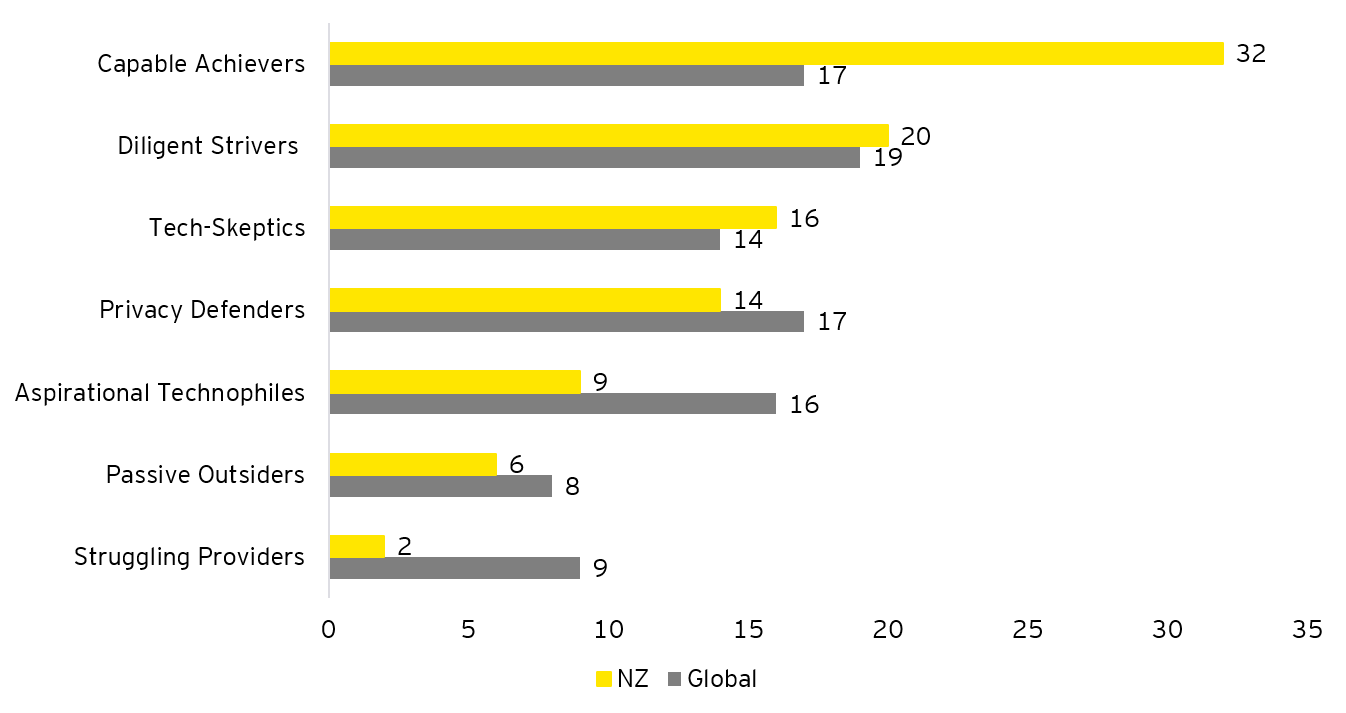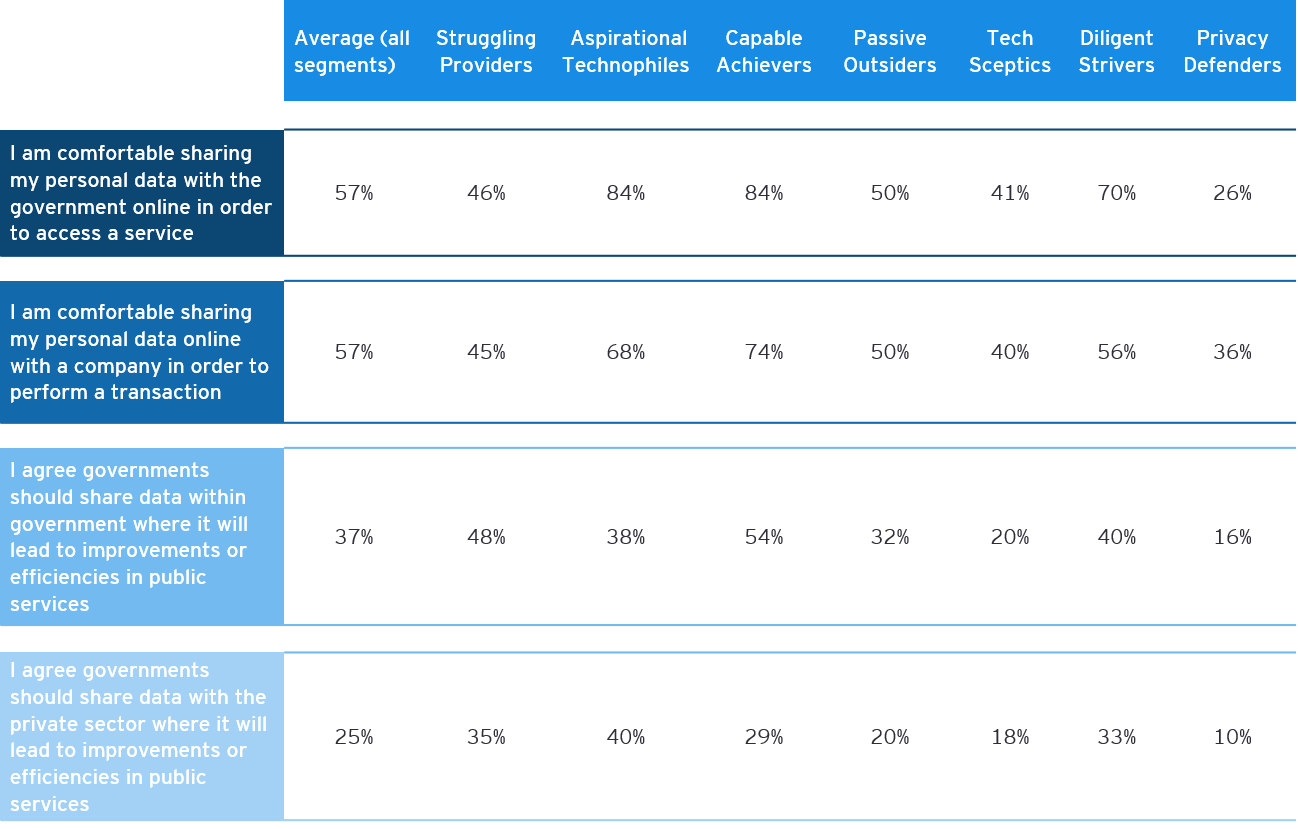Why does this matter? Almost one-third of global citizens rank more use of digital technologies in public service provision as one of the top three priorities for governments to improve service quality. So as governments move towards “digital by design” and “digital by default” approaches to service delivery, these personas can help governments ensure that digital services and data policies are properly designed across these different cohorts.
For example, what happens to the Struggling Providers — who may need the most support — if digital channels are the only way to access some services? Could they miss out on services and opportunities, and see the structural inequality they suffer from get worse?
Greater personalisation will help improve public policy design, deliver more efficient and effective public services, and strengthen the relationship between government and citizens. The citizen-centric approach will also shift the role of government beyond just being a regulator and service provider. Government will now need to become a participant in and facilitator of the digital economy.
In addition, as government services are extended and transformed, organisations rolling out these changes must establish and maintain trust with citizens, particularly with respect to data privacy and consent. An example of government leaning into these innovations is the Consumer Data Right (CDR) program, on 5 July 2021, the Government decided to implement a new legislative framework for a consumer data right. This will allow consumers to securely share data that is held about them with trusted third parties, using standardised data formats and interfaces. While the focus has been on financial services in the first instance, the CDR program is in line to be rolled out to other sectors such as energy and utilities.
Three priorities for governments
New Zealand policymakers should focus on three priorities as they strive to meet the multi-dimensional needs of citizens, engage them as co-producers of public value and deliver more effective and efficient digital services.
1) Trusted inclusive digital service delivery
Inclusive digital service delivery makes sense if it is framed around a new model of customer engagement. If government is going to solve the high capability versus low trust problem in New Zealand, inclusive and trustworthy systems will also need to be implemented and enabled.
Governments need to embark on a digital transformation program that focuses not just on how services are delivered, but also on what services are delivered. What’s required is a reshaping of public services enabled by technology, designed from the citizen’s perspective and on par or better than private sector services. This is the way to create public services that are differentiated yet inclusive, leaving no group behind.
A priority will be investment in high-speed digital infrastructure, including broadband and 5G networks, to provide connectivity in all parts of the country. With our nation lagging the digital infrastructure of many other developed countries, this is one of the critical challenges New Zealand policymakers need to urgently address. Governments can also help provide devices (like laptops and tablets) to get people online and run programs to improve people’s digital literacy so they have the skills and confidence to interact with digital services.
But governments will also need to ensure that those who are not digitally connected have alternative ways of accessing services. The requirement for no citizen to be disenfranchised is a major consideration for all public services.
Citizens already confident with technology have heightened expectations for service delivery, in terms of quality, speed, convenience and value for money. Governments will need to work to meet the expectations of these citizens, applying private sector standards. For example, now that the CDR has impacted expectations of how services are delivered to consumers, the New Zealand Government will also need to implement CDR for ‘Government-to-Citizen’ services.
Examples of digital services:
- Transparent data privacy, security and consent measures to establish and maintain trust in service delivery.
- Unique digital credentials that allow citizens to gain easier access to a range of services through multiple digital channels.
- Increasing the use of biometric data to facilitate more effective movement and access to services supported by trusted identity validation and verification of people.
- Smart portals and mobile apps that provide one-stop access to multiple government services, as well as pushing timely messages and updates. Integrating these across levels of government should be the ultimate goal.
- ”Tell us once” services so people don’t have to re-fill their personal data online for different government transactions, so that government operates as one intelligent, integrated system designed around the citizen (and businesses).
- Integrated digital platforms that enable data sharing across different government systems, creating a complete view of the citizen and organise services around people’s needs and life events.
- Smarter infrastructure and buildings that are IoT (Internet of Things) enabled providing intelligent cities to citizens.
- Full, digital end-to-end fulfilment of service requests that enable speedier delivery.
- Conversational platforms, with AI-powered chat bots, to interact with citizens, rapidly resolve queries and complete transactions.
- A true omnichannel experience, allowing people to access services on a variety of platforms using a range of devices that is AI enabled where possible
- Use of digital and emerging technologist to manage peak customer interaction volumes and delayed response times onset by disasters or emergency situations, enabling staff to focus on engaging with citizens that have unique or specialised circumstances.
Design thinking, customer experience labs and data analytics will help governments design their services to make each touchpoint better, faster and more efficient. The eventual goal is proactive and even predictive service delivery embedded in natural systems, where possible, reducing the administrative and compliance burden. This will ultimately free up resources to focus on those that need it most – the vulnerable in our society.
2) Responsible use and sharing of data and information
We’re producing and storing more data than ever before and now have the tools to analyse them for the public good. And while most people believe data analysis and technology will be needed to help solve increasingly complex future problems, they are concerned about widening social inequality, loss of human interaction and the potential encroachment on personal privacy and digital security.
With the evolvement of technology and reliance on the digital world during pandemic, there is a significant shift observed in the data usage when compared from previous years. As per NZ’s “Annual Telecommunications Monitoring Report” produced by Commerce Commission NZ’s on 16th March 2021, there has been an increase of mobile data consumption by 22% (3.3 Gb) and Broadband consumption by 37% (284 Gb).
The increase in production and storage of more data brings the risks and rewards at the same time.
While the rewards are enjoying digitalization, e-commerce, e-banking, interconnecting with the world from home, there are risks involved with the increasing data theft and cyber incidents. Further, based on the outcomes of the EY Global Information Security Survey (GISS) Report more than half of Oceania’s cybersecurity leaders (52%) say they have never felt as concerned as they do now about their ability to manage the cyber threat.
Usage of internet is not uniform when it comes down to age, gender, locations, ethnicity. This also raises the concern that user experience and wellbeing is not the same. As per the reports presented by Commerce Commission, 36.54% of population over 75 years old do not have access to the internet or are reluctant to access due to lack of skills.
Age and access to the internet




